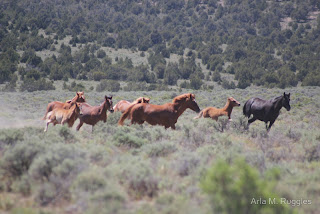(2/11.JUN.13)
I went out to check on the two Cherry Creek Bands that customarily make their homes along the eastern face of the Cherry Creek Mountain Range.
En route, I spotted two stallions skirmishing noisily (at first, I wasn't sure -- they might have been courting) about a quarter mile above the Curry Road, east of the fenceline, on the eastern bench of Cherry Creek Mountains.

I hoped they would be so engrossed in their frolicking, that I might be able to get close enough for a decent shot. I got out and started walking.

They continued their battle - not a very enthusastic joust, I thought - they were steadily moving south, toward town.
As I approached to within a few hundred yards, they decided I was a greater threat than either of them were, to each other. They split up and began running full tilt in opposite directions. 
I am not 100% posituve, but I think this is our old friend, Blaze.
The northbound guy ran and ran. I hurried back to my vehicle and followed him parallel on the road for about a mile. He ran until he came to a group of about a dozen horses - and kept running ....
 I could see that the bypassed horses were west of the fenceline, between the mountain and the fence. The sun was in my eyes, and I thought they might have been inside a smaller enclosure, so I headed up the nearest wash road, to see what I might see.
The horses above the fence bolted and ran up into the foothills, and thus I was able to ascertain that they were NOT closely confined.
I could see that the bypassed horses were west of the fenceline, between the mountain and the fence. The sun was in my eyes, and I thought they might have been inside a smaller enclosure, so I headed up the nearest wash road, to see what I might see.
The horses above the fence bolted and ran up into the foothills, and thus I was able to ascertain that they were NOT closely confined.
 A big black mare among them gives me to think they are the band that usually ranges north of Goshute Creek. I have never seen them this far down, and I suspect they have been chased. They have always been more skittish than the Cherry Creek 8, and they scrambled as soon as I got within shooting distance. I don't think they can get through the fence, and they will be trapped when the helicopters come.
A big black mare among them gives me to think they are the band that usually ranges north of Goshute Creek. I have never seen them this far down, and I suspect they have been chased. They have always been more skittish than the Cherry Creek 8, and they scrambled as soon as I got within shooting distance. I don't think they can get through the fence, and they will be trapped when the helicopters come.
The Cherry Creek Eight are now NINE, with the arrival of a new foal. As I followed the larger Goshute Creek group, this small band headed north along the bench, and I was not able to get nearer to them.

The high desert is uncharacteristically lush and green, due to unusual amounts of precipitation, this year. Most notably, mustard grass is thick and thigh high. Water in run-off washes continues to flow above normal.
There are approximately two hundred cattle scattered sparsely along the road between Cherry Creek and the Green Ranch.
UPDATE: 2011.JUN.14
I returned to the area that I had seen the two wild bands, and I watched them from the road for a short time, knowing I would not be able to get closer. Both bands were moving north at a steady, unhurried pace along the foothills of the Cherry Creek Mountains, approximtely two miles apart.








